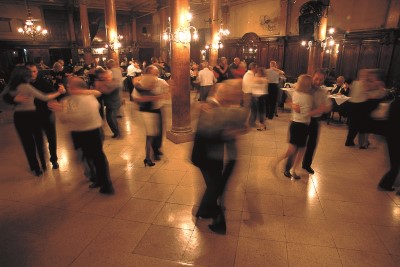Le tango est une danse et un genre musical emblématique de l’Argentine et de l’Uruguay, mais son histoire et son influence s’étendent bien au-delà des frontières sud-américaines. Originaire de Buenos Aires et de Montevideo à la fin du XIXe siècle, le tango est né de la fusion de diverses cultures et influences musicales. C’est une histoire riche de passion, de lutte et de migration qui a façonné ce phénomène culturel mondial.
Origines du Tango
Les racines du tango remontent aux quartiers populaires des grandes villes portuaires comme Buenos Aires et Montevideo, où se mêlaient des populations d’immigrants européens, d’esclaves africains affranchis et de gauchos argentins. Les rythmes africains, les mélodies espagnoles, les valses autrichiennes et les habaneras cubaines se sont mélangés pour créer une nouvelle forme d’expression musicale et dansée.
À l’origine, le tango était dansé dans les maisons closes et les bars des quartiers populaires, souvent par des hommes entre eux, avant de devenir socialement acceptable et de se propager dans les milieux plus respectables.
Évolution et diffusion

Le début du XXe siècle marque une période de transformation et d’acceptation pour le tango. Emmené par des figures emblématiques comme Carlos Gardel, la musique tango a commencé à gagner en popularité dans les salons de danse de Buenos Aires. Gardel, avec sa voix unique et son charisme, a joué un rôle crucial dans la popularisation du tango chanté.
Le tango a ensuite traversé l’Atlantique pour atteindre l’Europe. À Paris, la danse a connu un succès fulgurant dans les années 1910 et 1920, devenant un symbole de sophistication et d’élégance. Des artistes comme Astor Piazzolla ont révolutionné le genre en incorporant des éléments de jazz et de musique classique, créant le “tango nuevo”. Piazzolla est souvent crédité d’avoir renouvelé et modernisé le tango, le rendant pertinent pour de nouvelles générations.
Les Instruments et le Style Musical

Le tango est caractérisé par l’utilisation d’instruments spécifiques tels que le bandonéon, le violon, le piano et la guitare. Le bandonéon, un instrument de la famille des accordéons, est particulièrement associé au tango et est indispensable pour créer ce son distinctif et mélancolique. La musique tango se distingue par ses rythmes syncopés et ses mélodies expressives, souvent accompagnées de paroles poétiques évoquant l’amour et la nostalgie.
Le Tango Aujourd’hui

De nos jours, le tango reste une partie intégrante de la culture argentine et uruguayenne, avec des festivals, des compétitions et des milongas (soirées de danse tango) organisés régulièrement. Buenos Aires est considérée comme la capitale mondiale du tango, attirant des danseurs et des passionnés du monde entier. La ville abrite de nombreux lieux emblématiques, tels que le Café Tortoni et le quartier de San Telmo, où l’on peut encore ressentir l’esprit authentique du tango.
Le tango a également trouvé sa place dans les arts visuels et la littérature, inspirant des films, des pièces de théâtre et des œuvres littéraires. Il continue d’évoluer, influençant et étant influencé par d’autres formes d’art et de musique.
Le tango est un riche témoignage de l’histoire et de la culture des peuples qui l’ont créé et nourri. C’est une danse et une musique qui racontent des histoires de passion, de douleur et de résilience. Que ce soit dans les rues de Buenos Aires ou sur les scènes du monde entier, le tango continue de captiver et d’émouvoir, prouvant que ses racines sont aussi profondes que son allure est intemporelle.
Photos : Office du Tourisme de Buenos Aires








